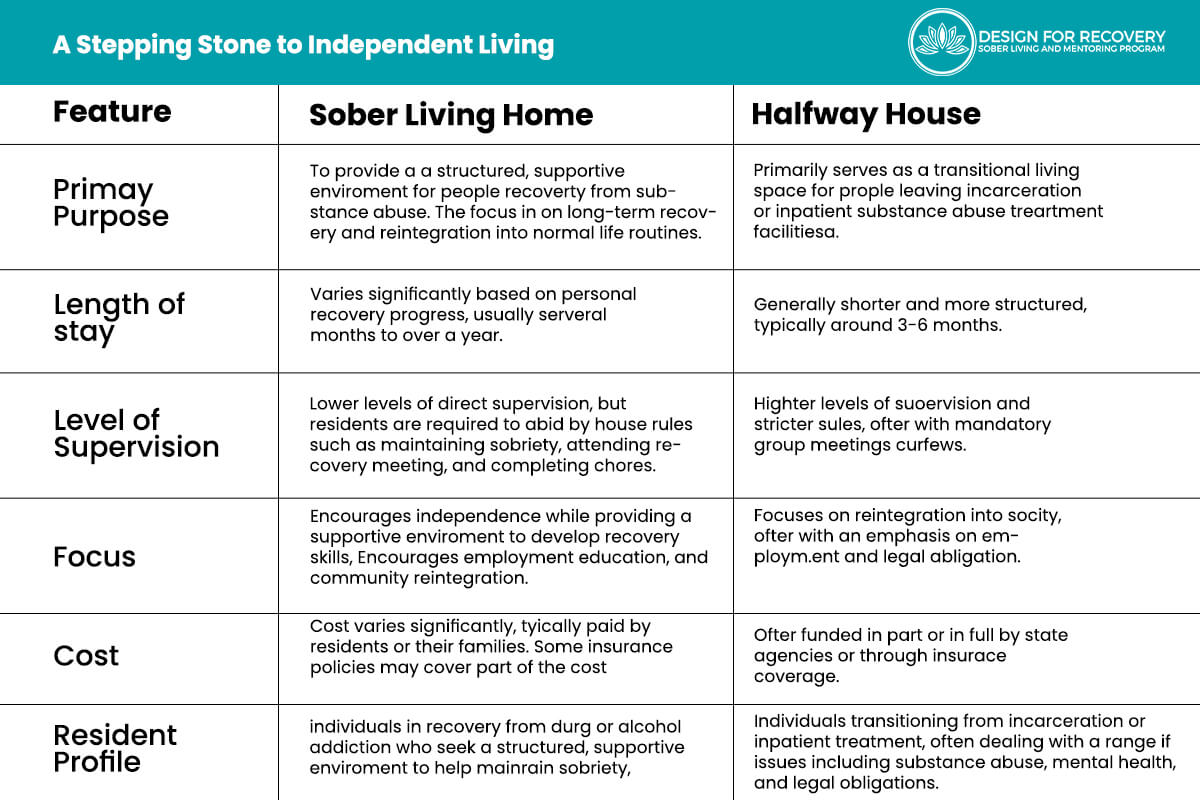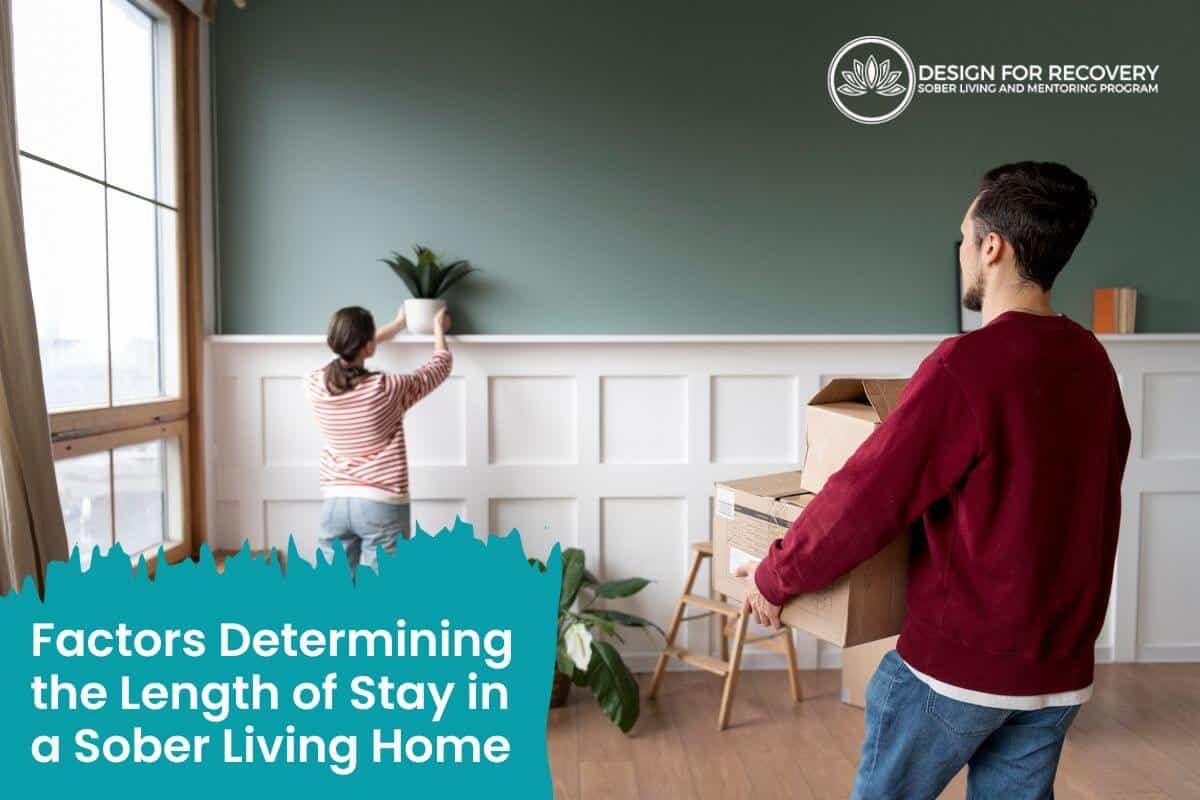When you’re on the road to recovery from addiction, knowing how long to stay in a Sober Living Home can be tricky. The timing isn’t one-size-fits-all; it depends on your personal healing journey and progress. So, let’s break it down together and help you understand what a Sober Living Home is, why the time you spend there matters, and how to figure out the best stay length for you.
On This Page:
Sober Living Home vs. Halfway House
A Sober Living Home (SLH) and a Halfway House are both integral components of the recovery journey for individuals who have struggled with drug abuse, alcohol rehab, or mental illness. However, they serve different functions and are structured differently, tailored to meet specific stages in the journey toward recovery and independent living.
Sober Living Homes: A Strong Support System
A Sober Living Home (SLH), often called a sober house or sober living facility, is a type of recovery residence that provides a sober environment for individuals recovering from substance abuse. The primary objective of sober living homes is to bridge the gap between an addiction treatment program and the real world, preparing residents to transition to a more independent lifestyle.
SLHs offer a strong support system. They instill house rules that all residents are required to follow, such as maintaining sobriety, attending regular recovery program meetings, and participating in household responsibilities.
Here’s what makes Sober Living Homes stand out:
They provide a sober living community for people recovering from substance abuse.
Sober living houses give residents the chance to develop new habits and coping skills necessary for long-term recovery.
Sober living homes often focus on mental health treatment, recognizing the role of mental illness in substance abuse.
SLHs offer emotional support through peer interactions, group sessions, and other programs dedicated to recovery.
They foster a sense of responsibility among residents. Time spent in a sober living home often leads to individuals feeling more confident and ready to face the same challenges in the real world but with newly learned coping mechanisms.
Halfway Houses: A Stepping Stone to Independent Living

On the other hand, halfway houses, often funded by national associations or governmental bodies, act as transitional living facilities for individuals who have completed an addiction treatment program or are reintegrating into society post-incarceration. The halfway house provides a structured environment to help these individuals adjust to an independent life.
Features that characterize halfway houses include:
They are generally more regimented than sober living homes. House rules can be stricter, and adherence is closely monitored.
Halfway houses often require residents to be either actively seeking employment or currently employed.
Treatment programs in halfway houses often involve dealing with the challenges of drug addiction, alcohol rehab, and mental health issues.
They may work closely with the criminal justice system, helping individuals meet legal obligations while supporting long-term recovery.
Halfway houses are often time-limited, meaning residents can only stay for a set period.
Though the sober living environment of both SLHs and halfway houses helps residents avoid relapses (statistics show that those who spent years in such environments remained sober longer), they cater to slightly different stages of recovery. Choosing between the two involves considering individual needs, recovery progress, and the level of independence and structure required.
The road to recovery is not easy, but it’s made significantly smoother with the help of facilities like sober living homes and halfway houses. The unique blend of structure, support, and freedom they provide paves the way for people recovering from addiction to return to everyday life with a significantly lower risk of relapse.
Understanding the Functioning and Rules of Sober Living Homes

What’s Day-to-Day Life Like in a Sober Living Home?
Sober Living Homes (SLHs) offer more than just a safe place to live; they provide a structured environment for recovery while encouraging an independent lifestyle. Living in an SLH is about learning to integrate the tools of recovery into daily life. So, what does a typical day in a sober house look like? Here’s a snapshot:
Follow the House Rules: SLHs operate on a set of rules to maintain a stable, sober environment. This might include assigned chores, curfews, and mandatory attendance at house meetings.
Attend Recovery Programs: Many SLHs require residents to participate in recovery programs such as therapy, counseling, or 12-step meetings.
Work, Study, or Volunteer: SLHs encourage residents to work, attend school, or volunteer during the day, helping to establish a normal daily routine that can continue after leaving the SLH.
Peer Support: Residents support each other in recovery. This might involve shared meals, group activities, or simply chatting at the end of the day.
What are the Rules and Regulations of Sober Living Homes?
Every Sober Living Home has its own set of rules, but some are pretty common across the board. These rules are designed to keep the house substance-free and supportive, helping everyone who lives there stay focused on their recovery. Here are some common rules:
Stay Sober: The most important rule is that residents must stay sober. No drugs or alcohol are allowed in the house.
Be Active in Your Recovery: This can include attending recovery meetings, seeing a therapist, or following a treatment plan.
Respect Curfew: SLHs usually have a curfew to ensure residents are safe and to promote a structured living environment.
No Overnight Guests: To maintain a stable, focused environment, overnight guests are typically not allowed.
Follow House Duties: Residents are often assigned chores to keep the house clean and to foster responsibility.
Breaking these rules can have consequences, including eviction from the home. Remember, these rules are in place to help, not hinder, your recovery. They provide a framework for living a sober, healthy life, both within the house and beyond.
Who Should Consider Joining a Sober Living House?

If you’ve tried to stay sober multiple times but have had repeated relapses, living in a sober house may offer the extra support needed to maintain sobriety. The structured environment and peer support system in place can significantly aid your recovery journey.
Below are scenarios where one might find an SLH to be the right choice:
Fresh Out of Rehab: If you’re fresh out of a substance abuse treatment program and are hesitant about re-entering your old environment, an SLH can provide a structured, substance-free environment to aid your recovery journey.
History of Relapses: If your recovery has been marred by relapses, especially after leaving rehab, living in a sober house might provide the supportive environment necessary to sustain long-term sobriety. The house rules of an SLH are designed to promote recovery and provide an accountability structure that is often beneficial for those struggling with relapses.
In Need of Stable Housing: For those grappling with drug or alcohol abuse, finding stable housing can be challenging. An SLH offers more than a roof over your head – it provides a supportive, sober environment where you can focus on your recovery without the stressors of unstable living conditions.
Seeking Peer Support: Weekly meetings are a common feature of SLHs, fostering a sense of community and mutual support. If you’re seeking to surround yourself with people who understand the challenges of recovery and can offer empathetic support, an SLH could be the right choice.
Desire for Long-Term Sobriety: If you’re committed to achieving long-term sobriety, an SLH can provide the tools, environment, and support necessary for that journey. Many who have spent years battling addiction and have remained sober credit their time in a sober living facility as a key component of their success.
In the end, the decision to join a sober living house is a personal one, rooted in individual needs and circumstances. SLHs are not a one-size-fits-all solution, but for many, they are an instrumental resource on the road to recovery.
Factors Determining the Length of Stay in a Sober Living Home

What Factors Influence the Duration of Stay?
Several factors contribute to the duration of your stay in a sober living home. These include:
Recovery Progress: How well you’re advancing in your recovery can significantly impact the length of your stay. If you’re making steady progress and demonstrating the ability to maintain sobriety, you might transition out of the sober home sooner.
Severity of Addiction: The depth of your addiction history also plays a role. Individuals with a more severe or prolonged history of substance abuse might need a longer stay to solidify the recovery process.
Mental Health Status: Co-occurring mental health disorders can complicate the recovery process. If you’re dealing with such challenges, additional time in an SLH might be beneficial to manage both your addiction and mental health needs effectively.
Financial Resources: The cost can also influence the duration of your stay. While many sober houses aim to be affordable, your financial situation could affect how long you can remain in the house.
How Long Should I Stay in Sober Living?
There is no universally recommended timeline for staying in an SLH. The American Addiction Centers suggest that many residents stay anywhere from several months to a year. However, it’s essential to remember that recovery is not a race but a personal journey.
Research by the National Association of Recovery Residences has indicated that individuals who stay longer in SLHs, often beyond a year, tend to have better recovery outcomes. The duration is generally flexible to accommodate the unique recovery path of each resident. The key is finding the balance between enough time to establish a strong foundation for sobriety without becoming overly dependent on the structure of the SLH.
The Typical Length of Stay and Costs Involved

What is the Average Length of Stay at a Sober Living Home?
While the length of time varies, residents’ average stay in sober living homes typically ranges from three months to over a year. This variation stems from the personal recovery journey of each resident, the severity of their addiction, and their readiness to transition into more independent living. There’s no one-size-fits-all timeframe, as the recovery process is as unique as the individuals undertaking it.
Maximum Duration of Stay in a Sober Living House
Most sober living facilities do not have a definitive cut-off time for residents, allowing for flexibility based on individual needs. The primary focus is to afford residents enough time to develop robust support systems and effective coping strategies for dealing with triggers in the real world. Remember, the goal is not to rush the process but to ensure each resident feels secure in their ability to maintain sobriety before leaving the structured environment of a sober living house.
How Much Does Sober Living Cost?
The cost of staying in a sober living home varies significantly, influenced by factors like location, amenities provided, and the level of support services available:
Low-Cost Homes: In some regions, sober living houses charge a few hundred dollars per month. These homes typically provide a more basic level of service and might be an ideal choice for those with limited financial resources.
Mid-Range Homes: The majority of sober living homes fall within a mid-range cost, charging somewhere between $1,500 and $2,500 per month. They usually offer a comfortable living environment, with some level of professional oversight and group therapy sessions.
High-End Homes: On the higher end of the spectrum, some sober living facilities can cost several thousand dollars per month. These homes often provide a wide range of amenities, more intensive support services and may be located in desirable areas.
Regardless of the cost, it’s crucial to consider the value of the support, structure, and guidance these homes offer in helping individuals maintain sobriety in their journey to recovery. Ultimately, investing in your recovery is an investment in a healthier, more fulfilling future.
Why Might a Longer Stay Be Beneficial?

Extending your stay in a sober living house offers several potential benefits that can strengthen your recovery journey. These benefits include:
Building New Habits: It takes time to replace old, destructive habits with healthier ones. A longer stay gives you the opportunity to establish and reinforce new routines and behaviors in a safe, supportive environment.
Forming Supportive Relationships: As you spend more time in the sober living facility, you have the chance to form deep, meaningful relationships with others who are also striving to live a sober life. These bonds can be a powerful source of support during and after your stay.
Boosting Confidence: Over time, you’ll gain confidence in your ability to navigate life without resorting to substance use. This self-assurance can be an essential asset when you transition to more independent living.
Staying longer provides a protective, substance-free environment and gives residents the time to heal, grow, and adapt to an independent life while building tools to prevent relapse.
However, a longer stay may also have some challenges. These may include financial constraints, adherence to house rules, and occasional conflicts with other residents. Effective communication and engagement in a supportive environment can help overcome these.
Deciding the Right Time to Leave

Deciding when to leave a sober living home can be just as critical as deciding to enter one in the first place. Here are some key considerations that might indicate it’s the right time to make the transition:
Stability in Sobriety: One of the primary indicators that you’re ready to leave is when you’ve maintained a stable period of sobriety. If you’ve remained sober for a significant stretch and feel confident in your ability to continue to do so, it might be time to move on.
Adapted to New Habits: The habits you’ve developed during your stay will serve as a cornerstone of your sober life outside. If you feel you’ve replaced destructive habits with healthier ones and these new routines have become second nature, it’s a good sign you’re ready to transition.
Financial Readiness: Being financially prepared to move out and sustain yourself is crucial. This includes being able to afford housing, food, and other necessities without compromising your ability to continue any needed treatments.
Solid Support System: Before leaving, ensure you have a robust support system in place outside the sober living facility. This could be a combination of family, friends, therapists, or support group members who understand your journey and can provide help when needed.
Ability to Handle Stress and Triggers: A significant part of recovery is learning how to manage stress and triggers without resorting to substance use. If you feel you’ve developed effective coping mechanisms and can navigate these challenges, you might be ready to leave the sober living home.
Following House Rules Has Become Restrictive: Sober living homes operate with rules to help residents maintain sobriety. However, there comes a point when these rules might feel restrictive, especially when you’re confident in your ability to stay sober without such structured oversight. It’s a sign you may be ready to transition if you’re at this stage.
While these factors provide guidance, it’s important to remember that deciding when to leave should not be a decision made in haste or isolation. Consulting with your support network, including therapists and staff at the sober living home, can provide valuable insight into whether you’re ready to move on to the next phase of your recovery journey.
Conclusion
Choosing the right length of stay in a sober living home is a deeply personal decision that should consider your recovery progress, emotional stability, and readiness to face the challenges of an independent lifestyle. As you navigate your recovery journey, remember that the objective is to stay sober and build a foundation for a healthy, satisfying life free from substance dependence.
Your Next Step: Find Strength and Support at Design for Recovery

Ready to take the next step in your recovery journey? Design for Recovery is here for you. Our sober living houses provide a structured, supportive environment tailored to your unique needs for long-term sobriety. Contact us today to begin your path toward a healthier, sober life. Let’s walk this journey together.








